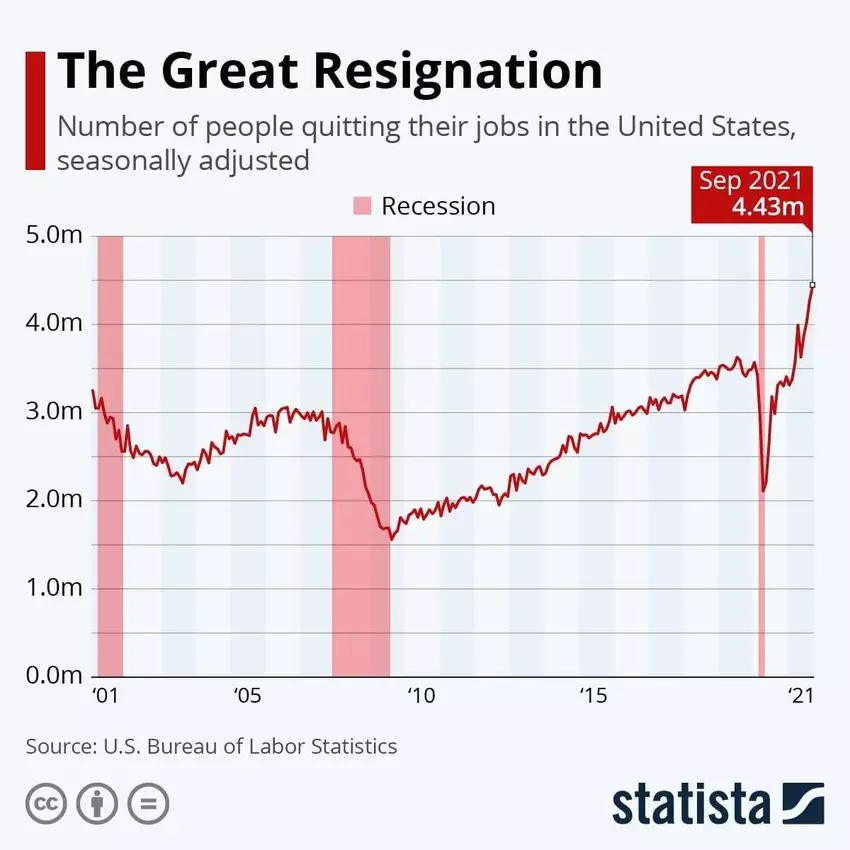“The Great Resignation”
In case you have not yet heard about this term, here’s what you should know.
- An economic trend
- Employees across multiple industries are quitting their jobs voluntarily in large numbers
- Started in the early months of 2021 in the United States
- Also known as “The Big Quit”
- Employers struggling to fill in open positions
- Trend slowly spreading worldwide

CAUSE?
By the end of July 2021, more than 4 million Americans put down their papers, and US employers were looking at almost 11 million job openings that needed to be filled as soon as possible. These numbers have been abnormally high when compared with historical data. With an event of this size, it is only natural to ask questions to get to the bottom of the issue: Who is causing this and why? The Harvard Business Review recently conducted a detailed research into this event by studying over 4,000 different employers and 9 million employees to draw meaningful patterns and build concrete conclusions for this problem. With sophisticated analytics running through such a large cluster of data, they were able to pinpoint the two biggest factors responsible for causing this snowball effect of mass resignations. Firstly, the data made it fairly evident that people working in the healthcare and tech industries showed the highest rate of resignations in the past year. Additional data suggests that not only healthcare but frontline workers across multiple industries quit their jobs in the last 6 months. A deeper look into this issue points all fingers towards the ongoing pandemic. During the peak of the pandemic, frontline employees were denied benefits like time-offs and instead were made to work longer hours due to increased demands. Such workers were immediately subjected to extreme stress, anxiety, and physical ailments caused due to these unfavorable psychosocial hazardous work environments. Increased workload led to burnout which eventually led to mass quitting. On the other hand, people working in tech had a different reason altogether but unsurprisingly had the same final affect – burnout. Around 90% to 95% of tech workers were working remotely during the pandemic. Employees quickly adjusted to the new normal and were as productive as before. However, multiple surveys and studies, over the course of the pandemic, quickly found out that employees were working way more than the standard 9 hours due to ease of access to work and increased demands during the pandemic. The result? You guessed it right – burnout due to increased stress and anxiety.
The second biggest reason that HBR’s study pointed out was demographics. The research found out that the majority of the resignations that were handed in were from mid-career employees between the ages of 30 to 45. This, too, can be tied to a very specific reason – safety. When the pandemic began, Gen Z and millennial employees between the ages of 20 to 25 were at greater risk of landing a new job because, with remote working, employers quickly hesitated from hiring folks with little to no experience. With little to no experience, any employee has to spend time in-person with the team or mentors to get a proper hang of work to take on the responsibilities efficiently. This was impossible with remote working. Therefore, the next best group of people that could take on newer responsibilities in newer organizations were the mid-career employees who were sufficiently experienced to hit the ground running. It could’ve also been possible that after all the high workload, limited staffing, and stagnant pay during the pandemic, the mid-level employees reached their breaking point and had the liberty to rethink their work-life balance while also being in the best position to switch jobs to suit their needs and wants. Either way, the resulting consequence could not have been any different – people quitting in large groups.
Also Read: An Alarming Trend in Employee Behavior
YOUR RESPONSIBILITY AS AN EMPLOYER
- Existing Employees: If you happen to be one of the unlucky ones who suffered from the Big Quit, your first step should not be to start looking for replacements instantly. The very first step you should be taking is to stop the bleed. Acknowledge the contributions of your existing employees. Show your appreciation towards their work and compensate them monetarily or in terms of benefits, without holding back. This builds trust, improves work culture, motivates people to do more, and makes people want to continue working with your company. After taking this step first, you might want to start building on your hiring strategies to backfill the lost positions. Additionally, you must also regularly collect employee feedback data, identify root causes of existing problems in work culture, and develop highly customized retention strategies to correct the wrongs that may exist in the culture. For example, if you discover members from a certain team leaving at a higher rate compared to other teams due to the leadership style of the manager, you must work towards a permanent solution to stop this problem. Regular feedback from employees helps avoid this problem and increases people’s trust in the company, which brings us to our next point: communication.
- Communication: Lack of communication compounds over a period of time only to return and stab you in the back at the worst possible time and when you expect it the least. When an employer is unable to convey or is deliberately trying to withhold information about what is going on, it creates confusion, breeds fear, propagates doubt, diminishes employee-employer trust, and instigates uncertainty within the company’s people. Once the wheel is set in motion, it can be challenging to avoid the disastrous consequences – like a tiny snowball rolling down a mountain and becoming a giant ball of death by the time it reaches the foot, destroying everything in its path. The smartest companies understand this and always try their best to prevent such events at all costs. The simplest form of avoiding greater damage is communicating the truth to the employees whenever you have new information and giving them hope for the future. It might seem counter-intuitive in many ways, but that’s what works best for a company’s reputation and success in the long run.
- Direction: In the face of uncertainties like natural disasters or pandemics, the only thing that gives hope to the workforce and keeps them going is continuous signs of progress. A recent survey from humu.com revealed that employees who didn’t have a clear and achievable goal or milestone were six times more likely to quit and join another company. Therefore, combating this issue is vital to the growth and retention rate of the organization. The managers are the ones who are majorly responsible for solving these problems in their teams and have to actively take the initiative in fighting ambiguity in the minds of their employees. A fair percentage of managers might resort to micromanaging by default – which has been proven to be the worst way to motivate employees. Micromanaging must be avoided at all costs. The best ways to keep the workforce motivated and focused on their goals are:
- To give employees clear, time-bound metrics for success
- Measure and manage
- Give direction
- Avoid micromanagement
- Allow higher autonomy
- Make them feel like they’re a part of something larger than themselves
- Identify unique skills in each employee and use them for collective growth
Exela HR Solutions offers end-to-end HR services to companies across different industries, around the world right from recruitment and payroll to corporate training and HRBP services. Speak to us today to optimize and standardize your people strategies for 2022.
Sources: google.com | humu.com | en.wikipedia.org | reddit.com | hbr.org | weforum.org
DISCLAIMER: The information on this site is for general information purposes only and is not intended to serve as legal advice. Laws governing the subject matter may change quickly, and Exela cannot guarantee that all the information on this site is current or correct. Should you have specific legal questions about any of the information on this site, you should consult with a licensed attorney in your area.
